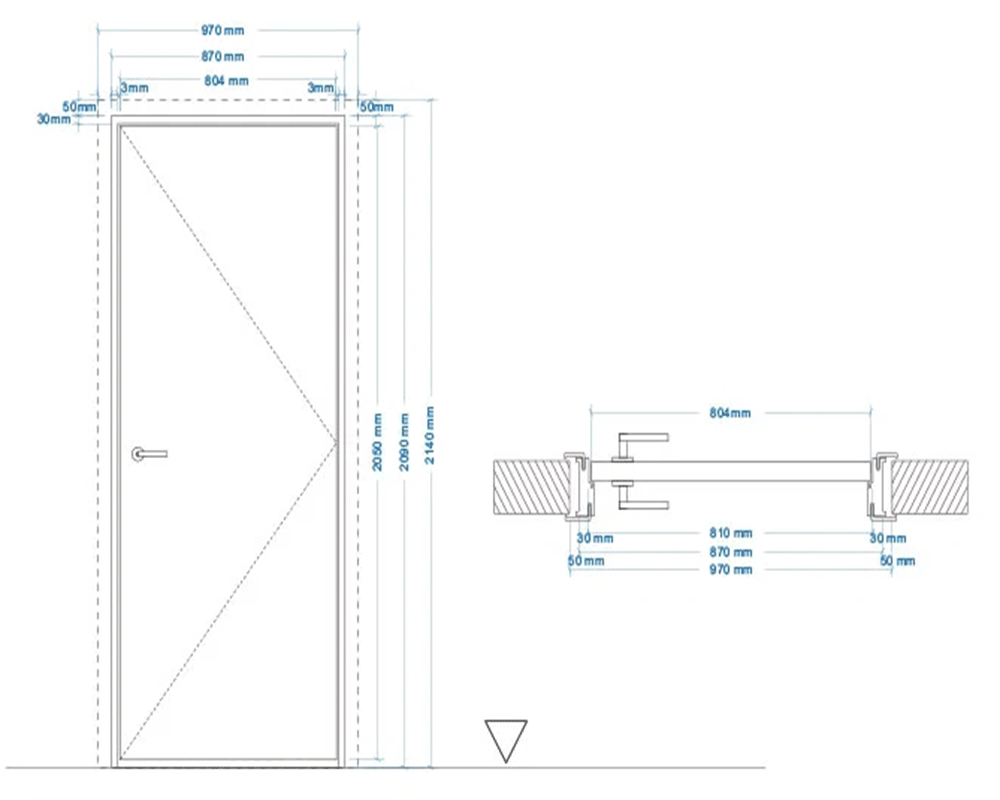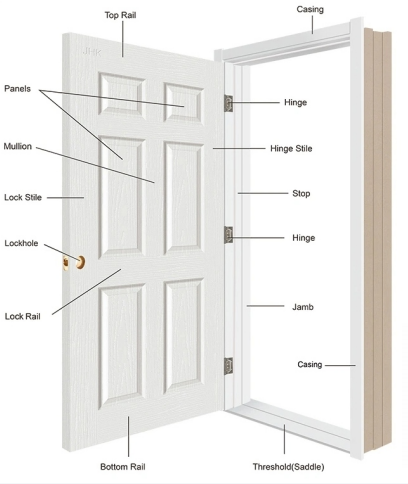Explore wooden door knowledge and choose your product now!
The Products BKOYIA Offers You
BKOYIA is a leading manufacturer specializing in the development and production of wooden doors. Our commitment to quality has made us a global supplier of wooden door solutions.
Our product lineup consists of three distinct series:

This series has various styles and low prices. The interior is made of honeycomb paper and the exterior is made of MDF and wood plastic, he will be the best choice for your project

The collection is eco-friendly and low to mid-budget. The interior is made of wood blocks and the exterior is made of MDF and melamine paper. If you are decorating your home or hotel, he will be your best choice

This series has good environmental protection, high budget, and high-end series. The interior is made of wood blocks and the exterior is made of MDF spray paint. If you are decorating a villa, it will be your best choice.
We provide 3 wooden door series: the standard size is 2100mm*900mm*200mm, which will fit the size of most areas.
In addition to our standard products, we are also proud to offer customized services tailored to individual processing requirements. Customize your own according to the size, style and material you provide.

Tailor your door’s style to match your vision. From modern to classic, we craft doors that uniquely embody your personal aesthetic

Every space deserves a perfect fit. We customize door sizes to meet your specific dimensions, ensuring flawless integration into your home or office

Choose your hardware to enhance your door. Choose from a range of high-quality door locks and hinges to add the finishing touches to your design
Wooden door structure combination
Door Slab: The main, flat part of the door, which can be solid wood or a composite with a wooden veneer. It’s the primary component that swings open and shut.
Frame: The framework that surrounds and supports the entire door system. It usually consists of the head, jambs, and threshold.
- Head: The horizontal piece forming the top of the frame.
- Jambs: The vertical sides of the frame.
- Threshold: The bottom part of the frame; it can be made of wood or other materials for durability.
Panels: Many wooden doors have panels – raised or recessed sections – adding to their visual appeal and structural integrity.
Rails and Stiles:
- Rails: Horizontal elements of the door’s structure.
- Stiles: Vertical elements, with the “lock stile” being on the lock side and the “hinge stile” on the hinge side.
Core: In some doors, especially exterior ones, the core might be filled with insulation materials for better energy efficiency.
Hinges: Metal pieces that attach the door to the frame, allowing it to swing open and closed.
Knob/Lever and Lockset: The handle and locking mechanism. There are various styles and security levels to choose from.
Peephole, Mail Slot, and Other Accessories: Depending on the door’s purpose, additional components like peepholes, mail slots, or decorative glass inserts might be included.
Weatherstripping: For exterior doors, weatherstripping is crucial for sealing against drafts and moisture.
Finish: The final surface treatment, which could be paint, stain, or varnish, that protects the wood and enhances its appearance.


Choose your material

Bridge tunnel mechanics plate
Principles of bridge tunnel mechanics plates: Principles of arch bridge tunnels
Features: It has the characteristics of high filling degree, sound insulation, heat preservation, fire prevention, environmental protection, etc. It is the door core material of high-end wooden doors. Applicable people: suitable for all kinds of people.

honeycomb paper
Principle: Principle of natural honeycomb structure Characteristics: It has the characteristics of light weight, low cost, high strength, smooth surface and not easy to deform, sound absorption, heat insulation, no pollution, etc., in line with the modern environmental protection trend. Applicable people: suitable for people with limited budget and renting houses.

solid wood
Pure solid wood door: Made of natural logs as the door core and processed by drying. Common woods include walnut, cherry, pear wood, etc. Pure solid wood doors have high requirements on production technology and require good dehydration and degreasing, otherwise they will easily deform and crack.

block
Attributes: It is a solid wood board filling, generally used for wooden doors. Features: Wood blocks are used as fillers. The processing accuracy of the thickness directly determines the flatness of the door. The production is cumbersome. Applicable people: Suitable for middle-class consumers.


Door Locks -------Hinges-------Door Stoppers
About hardware
What is hardware
Door Locks:
- Affordable Price: Traditional door locks are highly cost-effective, offering reliable security at a fraction of the cost of advanced locking systems.
- Easy Installation: These locks are straightforward to install, requiring only basic tools like a screwdriver, making them accessible for DIY installation.
- Simple Operation: Traditional locks are free from technical complexities, ensuring hassle-free, dependable use right after installation.
- Exclusive Key Access: Each lock is designed for a specific key shape, ensuring that only authorized keyholders can gain access.
Hinges:
- Easy Installation and Replacement: Compared to other hinge types, these are simpler to install and replace, making them a practical choice for various applications.
- Enhanced Durability: Ball bearing hinges offer smoother swing action and higher durability, reducing wear and tear, thus extending the lifespan of both the hinge and the door.
- Structural Support: These hinges provide enhanced structural support, distributing the door’s weight evenly, ensuring smooth and aligned movement, and minimizing warping and sagging. They are particularly suitable for wide doors.
Door Stoppers:
- Protecting Door and Wall: Door stoppers are essential in preventing damage to both doors and walls from forceful opening, maintaining the overall appearance of the space.
- Propping Doors Open: Certain door stoppers allow doors to stay open, useful in high-traffic areas or commercial settings like shops and restaurants.
- Adding to Decor: Door stoppers are not just functional; they can also enhance the decor. Available in various finishes, they can complement and add to the aesthetics of a room.
PVC wooden door production process
1. Material preparation
1. PVC sheet: Choose PVC sheet with good quality and suitable thickness as the main material of the door leaf.
2. Wood frame: Use high-quality wood, such as eucalyptus or oak, to make the frame structure of the door leaf.
3. Hardware accessories: Prepare the hardware accessories required for the door leaf, such as hinges, locks, etc.
2. Design
1. Determine the size and style of PVC wooden doors according to actual needs and architectural style.
2. Use CAD software to design and formulate the production process according to the design drawings.
3. Processing
1. Make the door leaf frame: According to the design drawings, use wood to make the frame structure of the door leaf to ensure that it is stable and strong.
2. Make PVC sheets: According to the size of the door leaf, cut the PVC sheets into corresponding shapes and sizes.
3. Position hardware accessories: Position and install appropriate hardware accessories on the door leaf frame and PVC sheet.

What can PVC wooden doors bring to customers?
PVC wooden doors blend the aesthetic appeal of wood with the durability and cost-effectiveness of PVC, catering to customers who value both style and budget-friendliness. The use of quality materials and processes like high-pressure lamination ensures these doors are resistant to wear, tear, and environmental factors, addressing longevity concerns. Customization options in sizes, styles, and finishes meet diverse architectural and design needs, satisfying those seeking specific aesthetic requirements. Additionally, these doors are more affordable compared to solid wood doors, offering a budget-friendly alternative without compromising quality. Their resistance to environmental conditions like humidity and UV radiation makes them suitable for various climates, while their ease of maintenance and installation adds to their practicality, making them a favored choice for customers prioritizing convenience and long-term value

What is an ecological door?
Ecological doors are based on naturally -based, using natural conditions and artificial means to create a comfortable and healthy product that is conducive to living.
Ecological doors are made of recyclable materials. While reducing damage to the human body, it can also reduce human harm to the environment.
It is very different from traditional wooden doors. The recycling of materials and less damage to the human body gradually become the choice of more consumers.
What are the advantages of ecological doors?
What are the advantages of ecological doors?
Harmicis to the human body:
The ecological door is a product derived from the concept of ecological homes. The key to ecological home is environmental protection and health. It belongs to the standard of green home. Therefore, ecological doors are harmless products of the human body.
Can recycling:
The ecological door is a door made of recyclable materials. This kind of material has no harm to nature, thereby reducing the pollution of the ecological environment and conforming to the concept of sustainable development and protecting the ecological environment.
The shape is simple and beautiful:
Compared with the traditional wooden door color style, the style of the ecological door is novel, the color is diverse, and it is suitable for the current popular modern style, minimalist style, minimalist style and so on.
Environmental health:
The ecological door eliminates environmental protection and health issues that people worry about, and will not produce harmful substances such as formaldehyde, toxic glue, and paint that may contain wood products.
More practicality:
Ecological doors of fire prevention, corrosion resistance, good sealing, and never fade can provide consumers with more practical functions. For home life, they can better enjoy the beauty and practicality of the ecological door.



The crashing door
Preparation:
- Door preparation involves choosing suitable wood and crafting the required door panels.
- Surface preparation ensures the door’s surface is smooth and free from impurities for effective coating adhesion.
Primer Application:
- A primer coat is applied to the door’s surface to enhance adhesion, level the surface, and protect the wood from water absorption and corrosion.
Sanding and Coating:
- Post-priming, the door is sanded to smooth the surface before applying paint.
- Painting involves using spray or brush techniques, often applying multiple layers with sanding and cleaning between coats for a smooth finish.
Drying and Curing:
- The door is placed in a controlled-temperature drying room to remove moisture from the paint layers.
- A curing chamber is used post-drying to enhance the durability and quality of the coating.
Finishing Touches:
- After curing, the door undergoes fine sanding and polishing to ensure an even surface and enhance its gloss.
- The final finish, whether it be a rich varnish or a vibrant paint, accentuates the material’s beauty and design nuances.
Quality Control and Delivery:
- The finished door undergoes inspection and quality control checks to ensure it meets color, texture, and gloss standards.
- Once it passes inspection, the door is packaged and prepared for delivery to customers or distributors.
Advantages of the paint door
Aesthetic Appeal: They provide a smooth, glossy finish that enhances the door’s visual appeal, making them a stylish addition to any interior.
Durability: Lacquered doors are resistant to moisture and wear, ensuring longevity and maintaining their appearance over time.
Low Maintenance: They are easy to clean and maintain, requiring only simple wiping to remove dust or stains.
Color Stability: The lacquer finish helps in retaining the color and prevents fading, keeping the door vibrant for years.
Protection: Lacquered coating protects the door from environmental factors, reducing the risk of warping or damage.

What we do
Product display
Crafting Elegance: Where Style Meets Substance in Every Detail

01

02

03

04

05

06
Precautions
Package Inspection: Upon opening the package, inspect all components for damage during transit. Missing or damaged parts can affect the door’s integrity and appearance.
Correct Assembly: Follow the manufacturer’s instructions for joining the frame accurately to ensure structural stability and proper door operation.
Stable Foundation: When standing the frame, make sure it is level and plumb. An uneven frame can lead to issues with door alignment and closing.
Secure Installation: Confirm that the frame is securely fastened to the wall opening with appropriate fixtures. Inadequate fixation can result in a safety hazard.
Sealant Application: Install rubber seal strips correctly to provide insulation and protection from water and air leaks, which could otherwise lead to energy loss and damage.
Door Leaf Alignment: Ensure that the door leaf is properly installed within the frame, with even gaps on all sides for smooth operation and to prevent sticking.
Architrave Fitting: Fit the architraves carefully to cover the gap between the frame and the wall, preventing drafts and enhancing the door’s appearance.
Lock Mechanism: Install the lock mechanism precisely as misalignment can compromise security and functionality.
Finishing Touches: After sealing with glue, clean any excess or spills immediately to prevent damage to the door’s finish and to maintain a clean, professional look.

